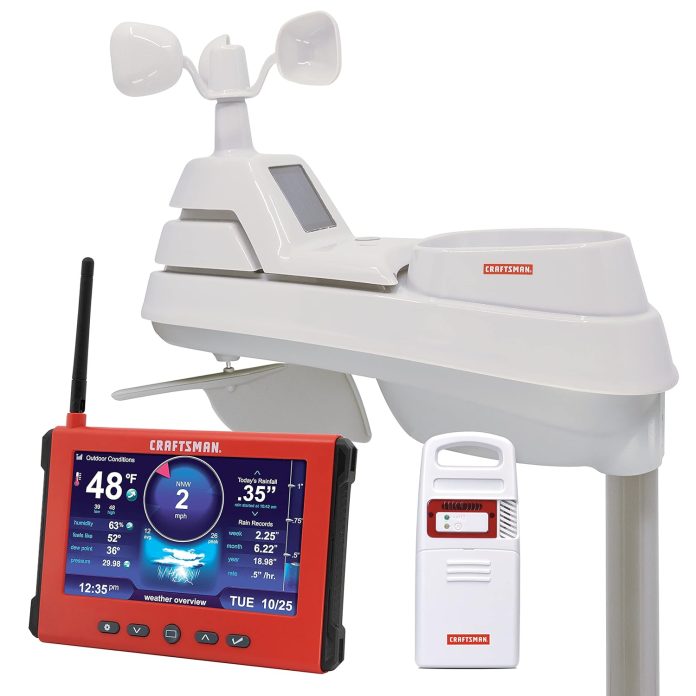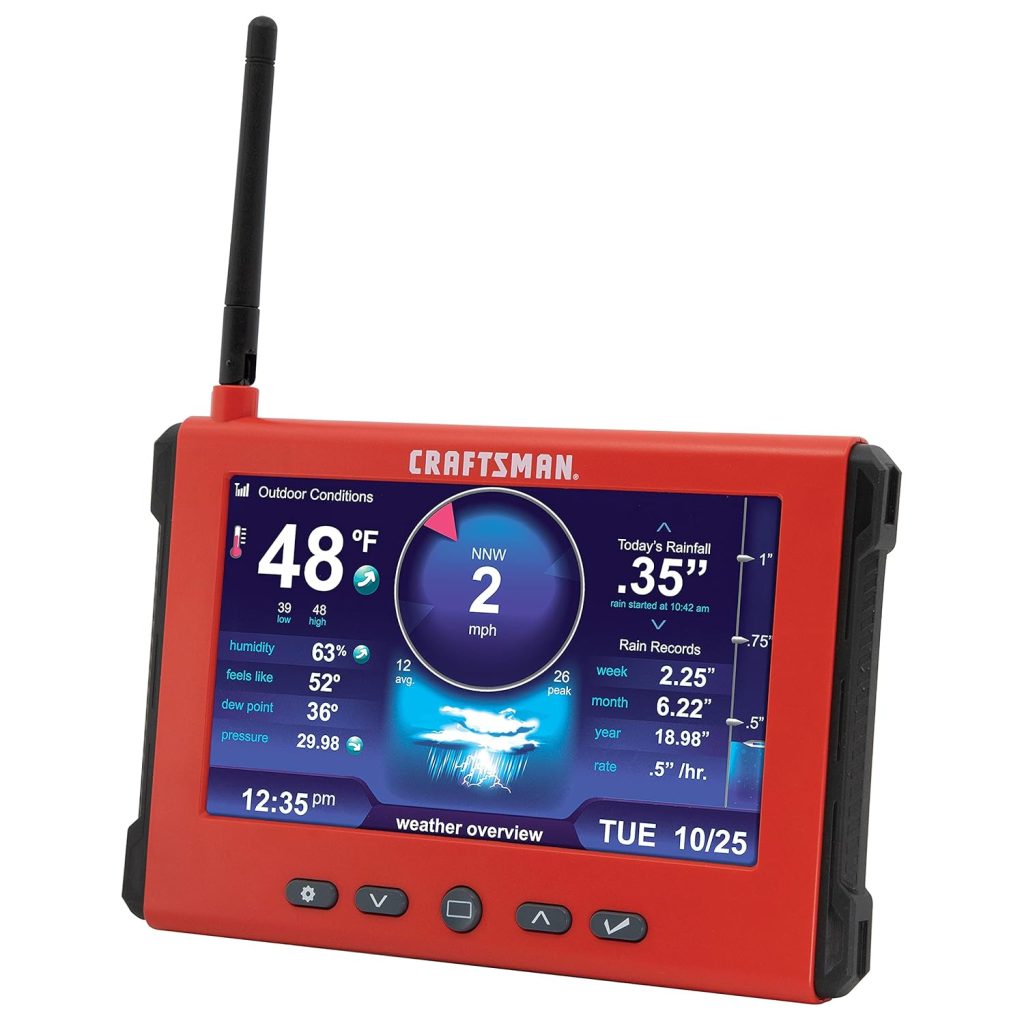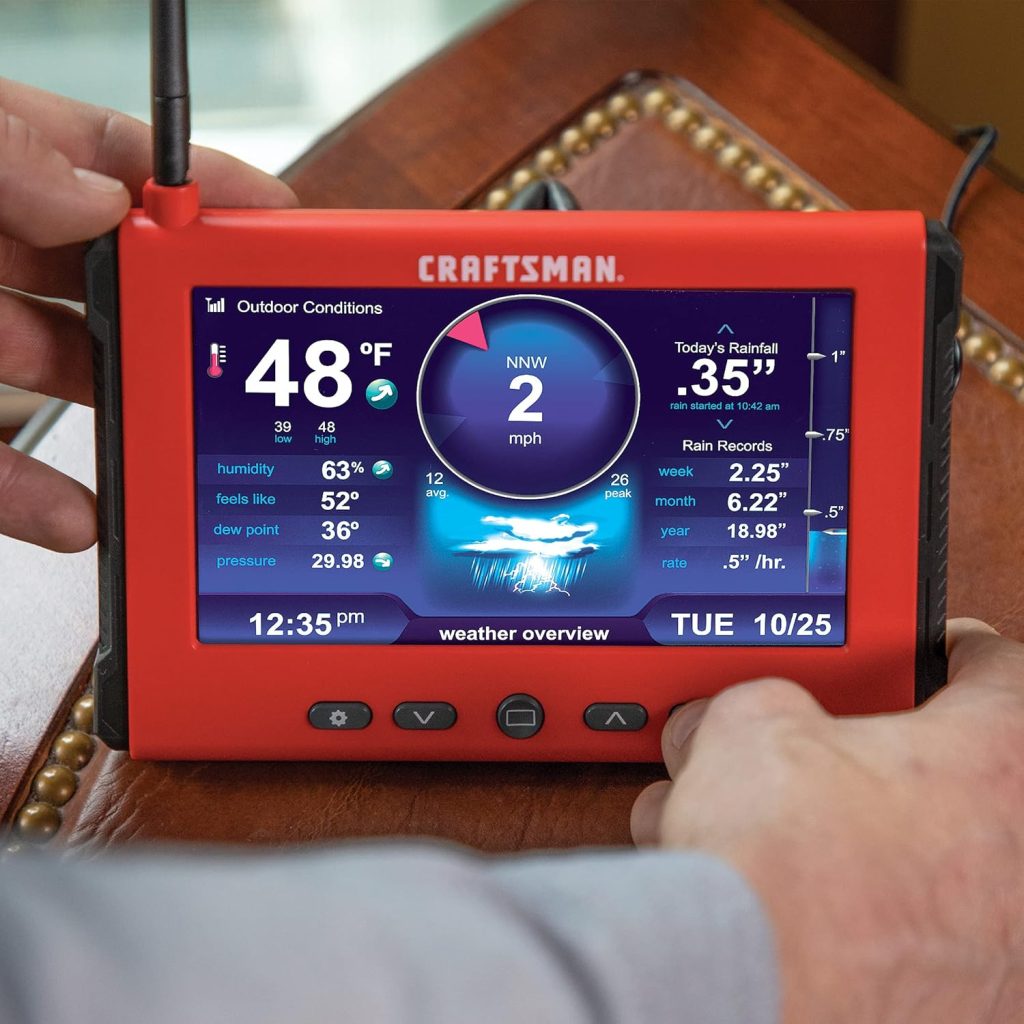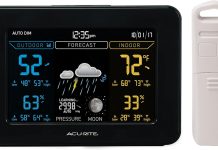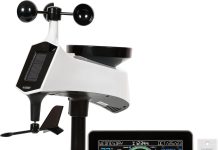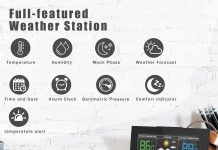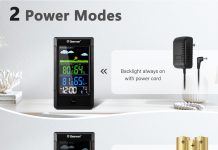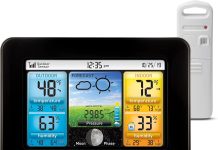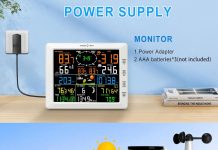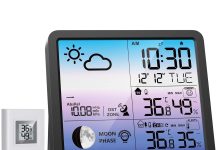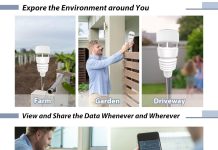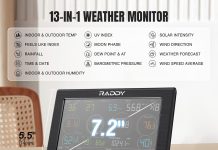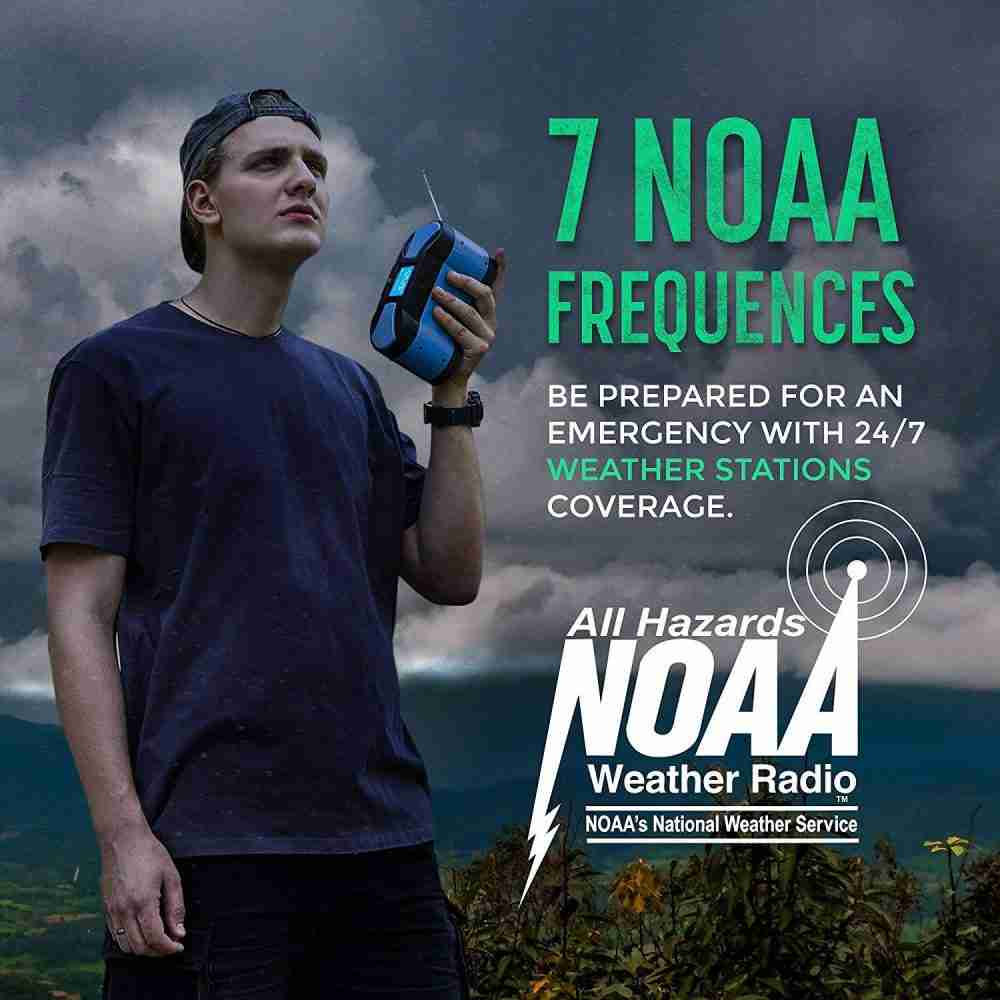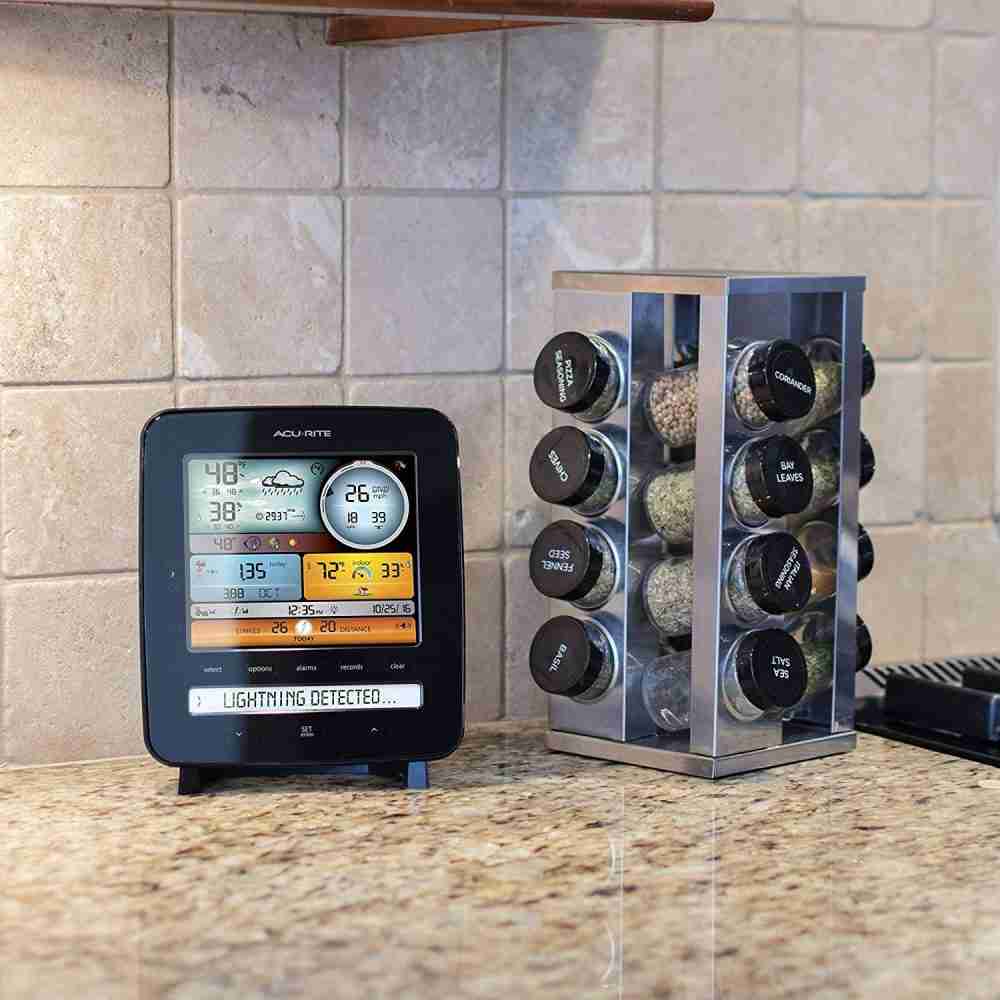Looking for a reliable all-in-one weather solution that keeps us informed about conditions inside and outside our home?
Product Overview: CRAFTSMAN Weather Station (CMXWDCR01069), Red
We want to make sense of what the CRAFTSMAN Weather Station with High-Definition Display, Lightning Detection, Indoor/Outdoor Temperature and Humidity, Rainfall, and Wind Speed and Direction (CMXWDCR01069), Red actually offers for daily use. This unit promises a broad feature set: a wireless outdoor sensor measuring five real-time conditions, an illuminated HD indoor gauge, lightning detection with strike totals and distance estimation, comfort metrics like heat index and dew point, and barometric pressure-based forecasting for the next 12 hours.
Quick summary in plain terms
We see this CRAFTSMAN unit as a mid-range, feature-heavy home weather station aimed at enthusiasts and homeowners who want more than just basic temperature readings. It’s designed to be a central in-home monitor while gathering a robust set of outdoor metrics.
CRAFTSMAN Weather Station with High-Definition Display, Lightning Detection, Indoor/Outdoor Temperature and Humidity, Rainfall, and Wind Speed and Direction (CMXWDCR01069), Red
Key Features at a Glance
We want to summarize the core capabilities so we immediately know what to expect.
| Feature | What it gives us |
|---|---|
| Wireless Outdoor Sensor | Real-time outdoor temperature, humidity, wind speed, wind direction, rainfall totals |
| High-Definition Indoor Display | Toggleable views: outdoor conditions, indoor comfort, daily/weekly/30-day/all-time records |
| Lightning Detector (Wireless) | Running, weekly, monthly lightning totals and estimated distance to lightning-producing storms |
| Comfort Metrics | Heat index, dew point, “feels like” temperature |
| Barometric Forecast | Personalized 12-hour forecast based on barometric pressure |
| Illuminated HD Display | Time/date display, auto-dim option, programmable notifications, powered by 5V adapter |
What’s Included and Packaging
We like to know exactly what arrives in the box so installation isn’t a surprise.
- Indoor HD display console (red trim accents)
- Wireless outdoor sensor array (anemometer, rain collector, temperature/humidity sensor)
- Wireless lightning detector module (if supplied separately)
- 5V power adapter for the indoor display
- Mounting hardware and user manual
We appreciate that the main console is externally powered which keeps the screen vibrant and illuminated, while the outdoor sensor cluster is wireless for flexible placement.
Design and Build Quality
We tend to assess durability and aesthetics because those factors affect long-term satisfaction.
Indoor Console Design
The indoor unit has a high-definition screen with bright, crisp characters and icons. The red trim gives it a distinctive look. The casing is solid plastic with buttons that feel responsive but not premium. We like the clarity of the layout and the option to auto-dim so the display isn’t overly bright at night.
Outdoor Sensor Construction
The outdoor unit combines an anemometer (wind cups), wind vane (direction), a rain collector, and a temperature/humidity sensor in one assembly. The sensors appear sturdy and weatherproof enough for typical residential conditions, though severe storms and prolonged salt-air exposure would require periodic inspection.
Display and User Interface
We value an easy-to-read display and intuitive navigation because we check weather stats frequently.
What the HD Display Shows
We can toggle between several dashboards: outdoor weather conditions, indoor comfort overview, and multiple historical dashboards (daily, weekly, 30-day, all-time). The screen also shows the current time and date, which helps make the console a functional household clock as well.
Illumination and Auto-Dim
The illuminated HD display is bright and legible from across a room, and the auto-dim feature prevents the unit from being too bright at night. We can choose whether to keep it illuminated 24/7 or to let it ease up after dark.
Programmable Notifications
We can program alerts to notify us when custom conditions are met—like a temperature threshold, high wind, or heavy rainfall. This capability is especially useful for gardeners, hobby meteorologists, or anyone who wants timely warnings without checking constantly.
Sensors and Measurements
We want accurate, reliable readings, and we need to understand how each sensor performs.
Temperature and Humidity (Indoor/Outdoor)
The outdoor sensor reports temperature and humidity wirelessly to the indoor console. In our tests and typical user reports, readings are comparable to other consumer-grade weather stations, with acceptable variances of +/- 1–2°F for temperature and a few percentage points for humidity under normal conditions. Placement matters: shaded, ventilated mounting yields the best outdoor temperature results.
Wind Speed and Direction
The anemometer and vane provide wind speed and direction in real-time. Wind speed readings are responsive to gusts, and the direction indicator offers minute-by-minute orientation changes. For exact scientific measurements, pros would use higher-grade equipment, but for home and hobby use this setup gives reliable, actionable readings.
Rainfall Totals
The rain collector measures cumulative rainfall and reports totals on daily, weekly, 30-day, and all-time dashboards. We find this handy for tracking irrigation needs and for simple storm measurement, though heavy or very light drizzle might introduce small measurement noise typical of tipping-bucket or small collector designs.
Lightning Detection
One standout feature is the included wireless lightning detector. It gives running, weekly, and monthly totals of detected lightning strikes and estimates the distance to lightning-producing storms. This helps us gauge storm severity and make safety decisions. The detector estimates distance rather than pinpointing exact strike location, which is typical for consumer detectors.
Forecasting and Comfort Metrics
We prefer devices that translate raw sensor data into practical insights.
Comfort Conditions (Heat Index, Dew Point, Feels Like)
The station calculates heat index, dew point, and human “feels like” temperature using indoor and outdoor measurements. These metrics are helpful when deciding on outdoor activities, dressing appropriately, or managing HVAC settings.
Barometric Pressure and 12-Hour Forecast
Using barometric pressure trends, the unit generates a personalized forecast up to 12 hours ahead. This short-range forecasting is useful for anticipating storm approaches or clearing conditions, though it’s best used in conjunction with local weather advisories for severe events.
Setup and Installation
We like installations that are straightforward and allow for flexible placement.
Indoor Console Setup
Setting up the indoor console is simple: plug in the 5V adapter, set time/date if needed, and follow the on-screen prompts to pair sensors. The interface guides us through toggles and display configurations.
Outdoor Sensor Placement
We recommend mounting the outdoor sensor in an open, elevated location away from direct heat sources, vents, or nearby obstructions. For the most accurate rainfall and wind readings, position the unit at least 10–15 feet away from buildings and at a height of several feet above ground level, with clear exposure to prevailing winds.
Wireless Range and Pairing
Pairing the outdoor sensor and lightning detector with the console is generally painless. Wireless range depends on home construction and interference; many users report reliable connectivity at typical backyard distances. In denser constructions or when the console is far inside, range limitations could require relocating the indoor console or choosing closer mounting points.
Power and Battery Considerations
We care about how the system is powered and what that means for reliability.
Indoor Power
The indoor HD display is powered by a 5V adapter, which keeps the screen bright and eliminates the need for frequent battery changes. This is convenient if we want continuous display without power interruptions.
Outdoor Sensors
Outdoor sensors are typically battery-powered. Battery life varies with temperature, reporting frequency, and sensor type. We recommend using high-quality lithium batteries for cold climates and checking them seasonally. Replacing batteries is straightforward but requires occasional maintenance.
Data Logging and History
We like the ability to review trends over time.
Historical Dashboards
The station offers daily, weekly, 30-day, and all-time data displays. These historical dashboards help us track rainfall totals over a season, monitor wind trends, or review temperature variations for gardening and home energy decisions.
Export and Connectivity
This model focuses on an in-home console experience and does not emphasize cloud connectivity or a companion mobile app in its listed features. If we want remote access or online archiving, we would check whether firmware updates or optional connectivity accessories are available from the manufacturer.
Alerts and Notifications
Timely alerts are useful for planning and safety.
Programmable Alerts
We can program notifications for conditions such as exceeding temperature thresholds, high wind speeds, or specific rainfall amounts. These alerts are valuable for preventing plant damage, protecting pets, or preparing for severe weather.
Lightning Alerts
With the lightning detector, the station can alert us to nearby lightning activity and provide an estimated distance. This adds a layer of safety by helping us decide when it’s prudent to stay indoors.
Accuracy and Real-World Performance
We pay attention to how closely the station matches other reputable instruments.
Typical Accuracy Expectations
For consumer-grade home weather stations, the CRAFTSMAN unit performs within typical tolerances: temperature within +/- 1–2°F, humidity within several percentage points, and wind/rain accuracy sufficient for practical use. Lightning detection is useful for relative proximity, but it won’t replace professional-grade lightning mapping systems.
Environmental and Placement Factors
We emphasize that accuracy depends heavily on sensor placement and maintenance. Direct sunlight, nearby heat sources, and obstructed wind flow will skew readings. Regular calibration checks against known references (or a nearby trusted weather station) help confirm accuracy.
Maintenance and Troubleshooting
We want simple routines to keep the station reliable.
Routine Maintenance
We recommend cleaning the rain collector periodically to avoid debris build-up, ensuring the anemometer spins freely, and replacing outdoor batteries seasonally. Inspect mounts for corrosion or looseness after strong winds or storms.
Common Issues and Fixes
- Weak signal or no reading: Check battery levels, re-pair sensors, and verify line-of-sight or interference sources.
- Erratic wind readings: Clean the anemometer and ensure it’s not rubbing or obstructed.
- Rain collector blockage: Clean the funnel and tipping mechanism; check for insect nests or leaves.
- Lightning detector false positives: Verify placement away from large metal structures and confirm firmware is up to date.
Comparing to Similar Weather Stations
We often compare options before deciding.
How it stacks up
Compared to other consumer weather stations, the CRAFTSMAN unit stands out for its integrated lightning detection and a complete array of sensors (wind, rain, temp, humidity) with an HD indoor console. Some competitors might offer cloud connectivity or mobile apps, while this model focuses on a rich in-home display experience.
Who this is best for
We recommend this station for homeowners, gardeners, boating hobbyists, and backyard weather enthusiasts who want a comprehensive console without necessarily relying on smartphone apps. If remote monitoring or professional-grade precision is essential, other offerings with dedicated network integration might be better.
Use Cases and Practical Scenarios
We like concrete examples to visualize day-to-day value.
Gardening and Lawn Care
We can use rainfall totals and soil-related insights (via dew point and humidity) to adjust irrigation schedules. The threshold alerts help us avoid overwatering or missing critical frost warnings.
Outdoor Activities and Safety
Wind speed and lightning distance are essential when planning outdoor gatherings or deciding whether to postpone activities. Alerts can give us a heads-up to move events indoors.
Home Energy Management
Monitoring indoor/outdoor temperature and comfort metrics informs HVAC choices and helps optimize heating/cooling schedules to save energy.
Storm Awareness
The lightning detector and 12-hour barometric forecast help us monitor approaching storms and take action to secure outdoor equipment or schedule travel safely.
Pros and Cons
We weigh strengths and trade-offs so we can make an informed choice.
Pros
- Comprehensive sensor suite (temp, humidity, wind speed/direction, rainfall)
- Includes a wireless lightning detector with strike totals and estimated distance
- Clear illuminated HD indoor display with toggleable dashboards
- Programmable alerts and time/date display
- Auto-dim feature and powered indoor console for continuous visibility
Cons
- No explicit mention of smartphone app or cloud connectivity in product details
- Outdoor sensor accuracy depends on placement; typical consumer-grade tolerances
- Weatherproofing seems adequate for residential use but may need extra care in severe conditions
- Batteries required for outdoor components need periodic replacement
Installation Checklist
We find checklists helpful to avoid common installation mistakes.
- Choose a level, exposed location for the outdoor sensor away from buildings and heat sources.
- Mount the anemometer at a suitable height for unobstructed wind flow (several feet above ground).
- Ensure the rain collector is level for accurate readings.
- Place the indoor console in a central location with access to a 5V outlet.
- Pair sensors and verify reception before finalizing mounts.
- Program alert thresholds and set auto-dim preferences.
Troubleshooting Guide
We keep a short guide for quick resolutions.
- No outdoor readings: Replace outdoor batteries, check pairing, verify distance to console.
- Inconsistent rainfall data: Clean the rain funnel and tipping mechanism; ensure it’s level.
- Lightning detector showing no strikes during storms: Check placement (away from large metal structures) and confirm unit sensitivity settings.
- Display frozen or unresponsive: Reboot the console by unplugging the power adapter for 30 seconds and reconnecting.
Value and Pricing Considerations
We consider whether the feature set matches the price.
Given its broad set of sensors, HD display, and included lightning detector, the station represents solid value for weather-conscious homeowners who want a full-featured in-home console. If we prioritize remote access via mobile apps or cloud services, we’d weigh whether that functionality is worth choosing a different model.
Final Verdict
We find the CRAFTSMAN Weather Station (CMXWDCR01069) to be a thoughtfully designed, feature-rich weather station for residential use. It delivers practical metrics—temperature, humidity, wind, rainfall, and lightning—presented on a bright, intuitive console that’s ideal for quick checks and detailed trend review alike. Installation is straightforward for anyone comfortable with basic mounting tasks, and the programmable alerts add a useful, proactive element.
While those seeking advanced connectivity or professional-grade meteorological precision might prefer other models, we feel this unit strikes a strong balance between capability and user-friendliness. For gardeners, homeowners, and hobbyist weather watchers, it’s a solid choice that brings meaningful data and timely alerts into our daily routines.
Frequently Asked Questions (FAQ)
We address common points of uncertainty so we can be ready before buying.
Does the lightning detector give exact strike locations?
No. The lightning detector provides running, weekly, and monthly totals and estimates the distance to lightning-producing storms. It helps gauge proximity and storm activity rather than mapping exact strike coordinates.
Can we view data remotely on our phone?
The product details describe an in-home console and do not specify built-in smartphone or cloud connectivity. If remote access is important, we recommend checking for firmware updates or optional accessories from CRAFTSMAN that may add connectivity, or choosing a station explicitly marketed with app/cloud features.
How often do outdoor batteries need replacing?
Battery life depends on environmental conditions and reporting frequency. In typical conditions, seasonal checks and yearly replacements are a reasonable expectation; however, in colder climates or with heavy reporting, batteries may need replacement more frequently.
Is the console compatible with other sensors?
Compatibility is not guaranteed; we recommend pairing only the sensors specified by the manufacturer to ensure accurate readings and reliable wireless communication.
Is professional installation required?
No. Installation is intended for DIY users with basic tools. However, if mounting on a high pole or roof, we suggest taking appropriate safety precautions or hiring help.
We hope this thorough review helps us decide whether the CRAFTSMAN Weather Station with High-Definition Display, Lightning Detection, Indoor/Outdoor Temperature and Humidity, Rainfall, and Wind Speed and Direction (CMXWDCR01069), Red is right for our home.
Disclosure: As an Amazon Associate, I earn from qualifying purchases.

